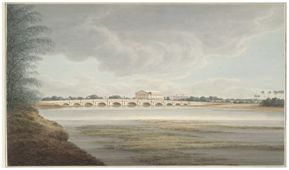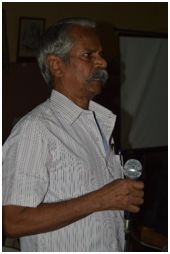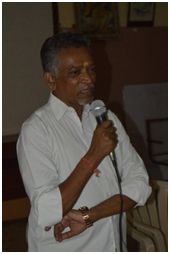REACH Foundation had celebrated the Madras Day this year on 9th September (Sunday) at the Prayer Hall of Ramakrishna Mission (South) School, Dhandapani Street, T. Nagar. This year had two eminent speakers of their own right Mr. D. Hemanth Rao (Retd. Civil Engineer, Numismatist and Madras Heritage Lovers Forum) and Mr. S. Ramachandran (Retd. Epigraphist, Tamilnadu State Archaeology Department and Faculty, A.A.S.A.I – Educational wing of REACH FOUNDATION) delivering unheard stories of Madras, the present-day Chennai.
Mr. H. Chandrasekaran (Trustee, REACH FOUNDATION) welcomed the guest speakers and the gathering by quoting the importance of Madras Day Celebrations. He also elucidated the intent of everyone to preserve the heritage of the city they live and love.
Then Mr. D.Hemanth Rao began his speech on the title ‘Graceful Arch Bridges of Madras’ by referring to the waterways of Madras Triplicane or Cooum river, Elambore river in the North and Adyar river on the South. Madrasapatnam was a sleepy fishermen village with only a sandy patch till Britishers occupied the northern side of the river Cooum. From time immemorial, these fishermen were crossing the two rivers Cooum and Adyar by fording when they were shallow water during summer or using small boats during monsoon.
Both the rivers were unpredictable during monsoon times as they get flooded. During 1639, there were many water bodies around the fort and were called ‘Drains’ or ‘Ditches’.
British traders were very much concerned about their business getting leaner during the monsoon as the locals were unable reach the fort as they have to cross the swollen river. It was Elihu Yale, who suggested building timber bridges to cross the drains outside the fort. The first Brick Arch bridge was built by an Armenian named Peter Uscan, across Saidapet river, or Adyar river at Saidapet named “Marmalong bridge” in 1726. One may conclude this be the FIRST MASONRY ARCH BRIDGE AT MADRASAPATNAM. Apart from few bridges close to the fort, it was in 1804, another major brick arch masonry bridge called St. George’s Bridge across river Cooum near Government garden was built by Lt. Thomas Fraser. This was a unique, Eleven Arch bridge with good ornamentation. Later bridges lacked in this aspect. One more fascinating bridge across river Cooum at Chintadripet was a “Suspension bridge”. After it’s collapse another Brick Arch bridge was built.
St. George’s Bridge over River Cooum 1804
The Government decided in 1840s that all ‘works’ should be given ‘on contract’. When the time came to build a new bridge across the Cooum in Chintadripet at the same location where, once, the suspension bridge was, the Military Board invited tenders and gave the contract to two local maistries, whose quotation was much lower than the estimated cost. The Superintending Engineer who built the bridge in 1804 painted it himself in 1805. He presented it to Sir John Sinclair of Ulster, with the above title.
He also referred to many forgotten Arch Bridges of Madras like Law’s Bridge over River CooumAt Chintadripettahbuilt in 1854, St. Andrew’s Bridge over River Cooumbuilt 1817, Harris Bridge over River Cooum 1854-55.
Mr. Hemanth Rao took the audience back to the 19th Century vividly narrating the story around the various other bridges like Anderson Bridge over River Cooum built during 1829, Elphinston Bridge over River AdyarIn1842, Basin Bridge over Buckingham Canal In 1807, Wallajah Bridge over Buckingham Canal In 1878, Ice House Bridge over Buckingham Canal 1878.
Then spoke Mr. Ramachandran on the title ‘Places in and around Chennai in Inscriptions’. He first referred the inscription found in Penneswara Madam near Krishnagiri of Kumara Kampanna period (1367 BCE) who established the Vijayanagara Empire by defeating the Sambuvarayars of North and Sultans of South mentions this area as ‘Mādarasaṉ Paṭṭiṉam’. Few more areas referred in the inscription includes ‘Nīla gaṅgaraiyaṉ Paṭṭiṉam’(present day Neelangarai), ‘Kōvaḷam’. (There is another version of the origin of the name ‘Madras’ as having connection with the word ‘Medeira’, the name of the Portuguese goddess as well. But it is a later phenomenon.)The port of Mādarasaṉ Paṭṭiṉam must have been situated on the confluence of river Cooum with Bay of Bengal. The adjacent village Chintadripet might have been the spot where customs and other offices were located. The name of the place seems to have some connection with the people who undertake voyage across the sea. (i.e.) ‘Sindu Yaathirai Pettai’. It will be pertinent to mention here that, there is one Vinayagar at Tarangampadi (Nagapattinam District) called Chintadri Vinayagar , a corrupt form of ‘Sindu Yaathirai Vinayagar’, who was worshipped by people before going on a voyage.
He also brought in the name of the Dutch settlement called ‘Sadras’ near Kalpakkam as ‘Sathira Vaasagan Pattinam’ in inscriptions of the 13th Century at Maramangalam near Korkai. It refers to the ‘Horses’ Import from Arabia around this region. Another 13th Century inscriptions refers to the present day ‘Kodambakkam’ as ‘Kodampakkai’, probably a market place, where horses were traded.
He also referred that around 15 years ago, one of the Epigraphists of the State Department Mr. Krishnamurthy had found one 13th Century inscription at Sembarambakkam near Madras stating the place as ‘Semmaram Battu’. Semmaram means red sanders, Battu seems to be the tamilised form of ‘baad’ which is used as a suffix in many place names (i.e.) Hyderabad, Secundarabad, Allahabad etc.
Mr. Ramachandran traced the renaming of the Madras Presidency into a tamil speaking state ‘Tamil Nadu’ during 2nd Nov 1956. Even Ganjam district of Orissa was part of Madras Presidency until the 1930s. During 1948, the Telugu speaking community in Madras Presidency raised a slogan ‘Madras Manadhe’ to claim the city for Telugu speaking community. In 1949, the Dhar commission was setup to reorganize the states on the linguistic basis. A demand to retain Madras as the headquarters of the state, where Tamil was the Lingua franca was submitted by Ma.Po. Sivagnanam. He organized a series of agitations with slogans ‘Save the State Capital even if we have to sacrifice our Head’ (Thalai Koduthaayinum Thalainagaram Kaapom). In 1952, when the first general election was conducted, Rajaji became the chief Minister of the Madras State. During that period, Potti Sriramulu under went a fast unto death for over 50 days with a demand that Madras be made the capital of a Telugu linguistic state. As a repercussion of his death, riots spread through out the border area of Telugu and Tamil linguistic regions. The Prime Minister Jawaharlal Nehru was also in favour of a compromise that Madras be made a temporary capital for both Tamil and Telugu linguistic states. Rajaji staunchly opposed the idea and even stated it very clearly to Mr. Jawaharlal Nehru. Thus, Madras was saved to be the Capital of Tamil Speaking population. History enthusiasts who are keen in celebrating the Madras Day have to be thankful to Mr. Ma. Po. Si and Mr. C.Rajagopalachari for retaining this city as the capital of Tamilnadu.
Mr. Oagai Natarajan, Editor of Yaali Magazine thanked the Guest Speakers for elucidating the unheard, unknown information about the Madras City. The event concluded with the National Anthem. The Guests were treated with a High tea at the end of the function. The attendees thanked REACH Foundation for arranging such informative session about the city.





